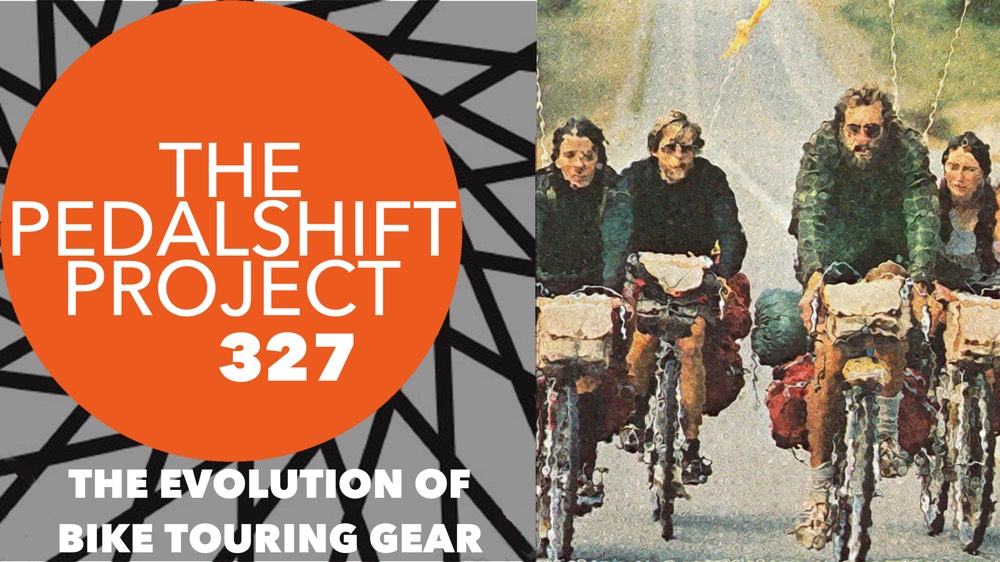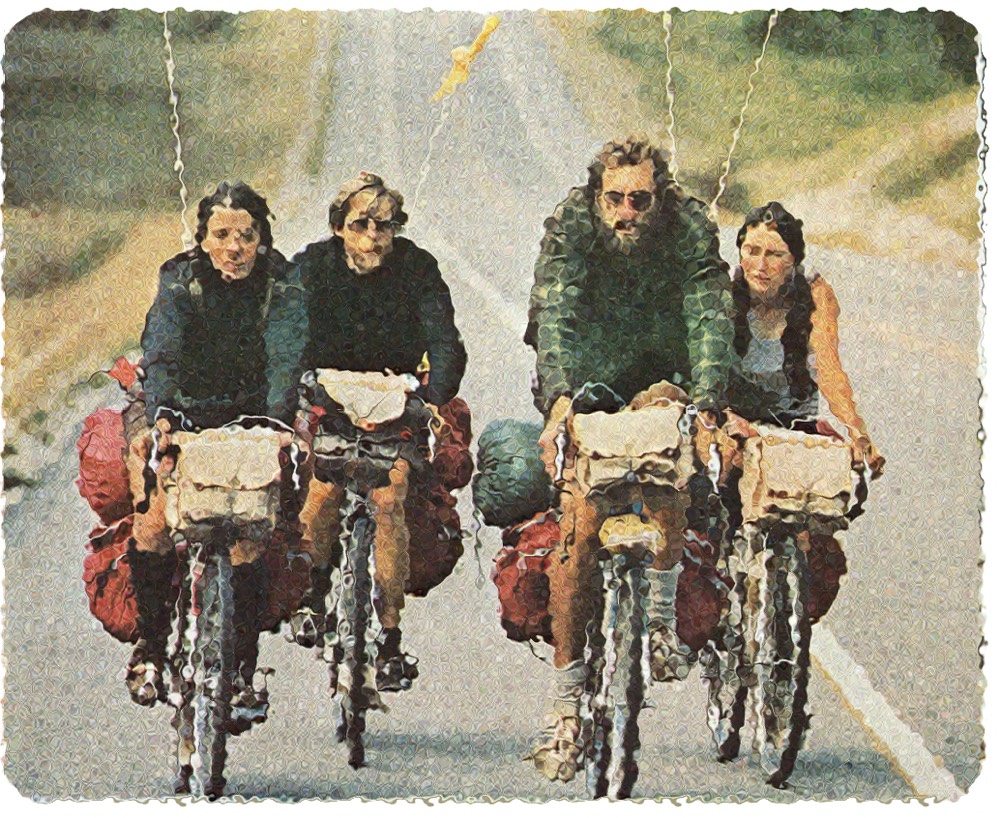Every once in a while it’s nice to look back on where it all came from – on this edition, we explore the evolution of bike touring gear from the beginning of the modern era in the 1970s through today’s high tech enhancements to bikepacking and more. Plus, a nod to what the future might hold with new materials and tech to make bicycle adventuring more fun and accessible!

Hey it’s the direct download link for The Pedalshift Project 327: The Evolution of Bike Touring Gear.
Subscribe/Follow The Pedalshift Project:
RSS – iTunes – Overcast – Android – Google Podcasts – Stitcher – TuneIn – IHeartRadio – Spotify
Reach out to the show via email, Twitter and Instagram. Don’t forget to join the newsletter too.
Have some bike touring or overnight stories to share? Send your pics, audio or a quick tweet – all welcome. Email the show at pedalshift@pedalshift.net or call the lightly-used Pedalshift voicemail line at (202) 930-1109
The Evolution of Bike Touring Gear (1970s-Present)
Bike Touring in the 1970s
-
Discuss the state of bike touring in the 1970s:
-
Bike touring during this era was gaining popularity as a way to explore the world and embark on long-distance adventures.
-
It was a time when people sought alternative modes of travel and embraced the freedom and simplicity that bike touring offered.
-
-
Overview of the popular bikes used for touring in that era:
-
Steel-framed touring bicycles were the go-to choice for bike tourers in the 1970s.
-
Brands like Raleigh, Peugeot, and Miyata were known for producing reliable touring bikes.
-
These bikes were designed with longer wheelbases and relaxed geometry to provide stability and comfort during long rides.
-
-
Introduction to the traditional panniers and racks used for carrying gear:
-
Panniers, typically made of canvas or nylon, were the primary means of carrying gear on bike tours.
-
They were attached to racks mounted on the front and rear of the bicycle.
-
These racks were often heavy and made of steel, adding extra weight to the bike.
-
-
Highlight the limitations and challenges of the gear available at the time:
-
Bike touring gear in the 1970s had some limitations.
-
The panniers were not as efficient at distributing weight evenly, which could affect bike handling and stability.
-
Additionally, the racks added significant weight to the bike, making climbs and maneuvering more challenging.
-
-
Share anecdotes and stories from notable bike tourers of the era:
-
Renowned bike tourers of the 1970s
-
Thomas Stevens, who completed the first documented bike trip around the world,
-
Anne Mustoe, who cycled around the globe in the 1980s.
-
Bikecentennial 1976
-
Technological Advancements in the 1980s and 1990s
-
Technological advancements that impacted bike touring gear in the 1980s and 1990s:
-
During this period, advancements in materials, components, and design significantly influenced bike touring gear, making it more efficient and comfortable.
-
Introduction of lightweight materials such as aluminum and titanium for bike frames and components:
-
Aluminum frames started gaining popularity in the 1980s due to their lighter weight compared to traditional steel frames.
-
Titanium frames, known for their strength and durability, also emerged as a high-end option for bike touring enthusiasts.
-
-
-
The emergence of clipless pedals and the impact on efficiency and comfort:
-
Clipless pedals, which allow riders to securely attach their shoes to the pedals, were introduced in the late 1980s.
-
This innovation improved pedaling efficiency and comfort, especially during long rides and climbs, by allowing for a more direct transfer of power.
-
-
Innovations in camping gear, including lighter tents, sleeping bags, and cooking equipment:
-
Camping gear manufacturers started focusing on lightweight designs in the 1980s and 1990s.
-
Tent materials, such as lightweight nylon and aluminum poles, reduced overall weight while maintaining durability.
-
Sleeping bags with improved insulation and smaller pack sizes became popular, and compact cooking stoves provided efficient meal preparation options.
-
-
The rise of waterproof materials and improved clothing for inclement weather:
-
Waterproof materials like Gore-Tex became widely available during this era.
-
This allowed for the development of waterproof panniers and cycling apparel, keeping riders dry and comfortable in rainy conditions.
-
Clothing advancements included breathable and moisture-wicking fabrics that enhanced comfort during long rides.
-
The Rise of Bikepacking in the 2000s
-
Explain the concept of bikepacking and its differences from traditional bike touring:
-
Bikepacking is a form of self-supported, off-road bicycle travel that emphasizes lightweight gear and the ability to venture into rugged terrain.
-
Unlike traditional bike touring, which often involves paved roads and larger amounts of gear carried on racks, bikepacking focuses on carrying essential gear in frame bags, seat packs, and handlebar rolls.
-
-
Introduction to bikepacking-specific gear, such as frame bags, seat packs, and handlebar rolls:
-
Bikepacking gear is designed to optimize weight distribution and stability while navigating off-road terrain.
-
Frame bags attach to the bike’s main triangle, seat packs secure under the saddle, and handlebar rolls fasten to the handlebars, providing ample storage space while maintaining a balanced load.
-
-
The impact of mountain biking and gravel riding on the development of bikepacking gear:
-
The rise of gravel riding in the 2000s plus the influence of mountain biking impacted the development of bikepacking gear.
-
These disciplines demanded lightweight and durable gear that could withstand rough trails and demanding conditions.
-
As a result, bikepacking gear evolved to meet the specific needs of off-road adventurers.
-
-
Discuss the benefits and advantages of bikepacking gear in terms of weight distribution and off-road capabilities:
-
Bikepacking gear allows for a more balanced weight distribution, as the gear is distributed within the bike’s frame rather than on racks.
-
This improves handling and stability, especially on challenging terrain.
-
Bikepacking gear is also typically lighter and more compact, enabling riders to navigate through tight trails and rough conditions.
-
Downside… can’t carry as much!
-
Modern Bikepacking Gear and Trends
-
Lightweight and durable materials like Dyneema and Cuben Fiber
-
These materials offer exceptional strength-to-weight ratios, making gear lighter without sacrificing durability.
-
-
Integration of technology with bikepacking gear
-
For example, GPS navigation devices specifically designed for bikepackers have become popular, allowing for easier route planning and navigation in remote areas.
-
Additionally, solar-powered charging systems have been developed to keep electronic devices powered during extended trips.
-
Battery improvements
-
-
The emergence of bikepacking-specific clothing and accessories:
-
These items are designed to meet the unique demands of off-road riding, such as moisture-wicking and quick-drying fabrics, specialized bikepacking shoes, and rugged yet lightweight helmets.
-
None of this is new, but the tech is improving and costs for basics are dropping
-
-
Trends in minimalist bikepacking and ultra-distance races:
-
Discuss the rise of minimalist bikepacking, where riders aim to carry the bare minimum gear for maximum efficiency and speed.
-
Explore the growing popularity of ultra-distance bikepacking races, such as the Tour Divide or the RAM , and how gear choices impact participants’ strategies and performance.
-
-
Future Possibilities and Closing Thoughts
-
What’s next?
-
More evolution to bikepacking
-
Will “bike touring” ever go away?
-
Wrap up

As always we like to close out the show with a special shoutout to the Pedalshift Society! Because of support from listeners like you, Pedalshift is a weekly bicycle touring podcast with a global community, expanding into live shows and covering new tours like this summer’s upcoming bike tour! If you like what you hear, you can support the show for 5 bucks, 2 bucks or even a buck a month. And there’s one-shot and annual options if you’re not into the small monthly thing. Check it all out at pedalshift.net/society.
Kimberly Wilson
Caleb Jenkinson
Cameron Lien
Andrew MacGregor
Michael Hart
Keith Nagel
Brock Dittus
Thomas Skadow
Marco Lo
Terrance Manson
Harry Telgadas
Chris Barron
Mark Van Raam
Brad Hipwell
Mr. T
Nathan Poulton
Stephen Dickerson
Vince LoGreco
Cody Floerchinger
Tom Benenati
Greg Braithwaite
Sandy Pizzio
Jeff Muster
Seth Pollack
Joseph Quinn
Drue Porter
Byron Paterson
Joachim Raber
Ray Jackson
Jeff Frey
Kenny Mikey
Lisa Hart
John Denkler
Steve Hankel
Miguel Quinones
Alejandro Avilés-Reyes
Keith Spangler
Greg Towner
Dan Gebhart, RIP
Jody Dzuranin
Lucas Barwick
Michael Baker
Brian Bechtol
Reinhart Bigl
Greg Middlemis
Connie Moore
William Gothmann
Brian Benton
Joan Churchill
Mike Bender
Rick Weinberg
Billy Crafton
Gary Matushak
Greg L’Etoile-Lopes
James Sloan
Jonathan Dillard
John Funk
Tom Bilcze
Ronald Piroli
Dave Roll
Brian Hafner
Misha LeBlanc
Ari Messinger
David Gratke
Todd Groesbeck
Wally Estrella
Sue Reinert
John Leko
Stephen Granata
Phillip Mueller
Robert Lackey
Dominic Carol
Jacqi McCulloch
John Hickman
Carl Presseault
David Neves
Patty Louise
Terry Fitzgerald
Peter Steinmetz
Timothy Fitzpatrick
Michael Liszewski
Hank O’Donnell
David Zanoni
David Weil
Matthew Sponseller
Chad Reno
Spartan Dale
Carolyn Ferguson
Peggy Littlefield
Lauren Allansmith
Eric Burns
Thomas Pearl
Darrin McKibben
Richard Stewart
Dave Fletcher
Jack Smith
Luke Parkinson
Ryan Patterson
Cyrus Farivar
John Gardiner
Sam Scruggs
Music
You’ve been hearing about Jason Kent and his music for many fine episodes. Jason has a new solo album available NOW. Go listen to COMMON TONGUES wherever cool music is available!
